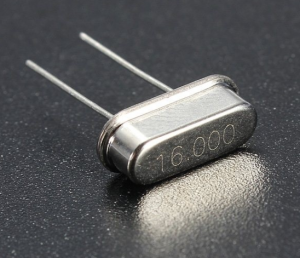How The 16Mhz Crystal Signal Works

The 16Mhz crystal signal is an important part of many electronic devices. It is used to control the timing of various operations within the device. Without this signal, the device would not be able to function correctly. In this blog post, we will explore how the 16Mhz crystal signal works. We will also discuss its importance in electronic devices and how it helps to keep them running smoothly.
What is a 16Mhz Crystal?
A 16 MHz crystal is a type of resonator that is used to create an oscillating signal at a frequency of 16 million hertz. The signal created by the crystal can be used to keep track of time or to provide a stable clock signal for digital electronics. Crystal oscillators are used in a wide variety of electronic devices, including computers, cell phones, and radios.
crystals have a very regular structure, with atoms arranged in a lattice. This regular structure allows them to vibrate at very precise frequencies. When an electrical current is applied to a crystal, it vibrates at its natural frequency. By selecting a crystal with the correct natural frequency, it is possible to create an oscillating signal at any desired frequency.
The most common type of crystal used in electronic devices is quartz crystal. Quartz crystals have a natural frequency of 32,768 Hz, which is why they are often used as the basis for timekeeping in watches and other devices. However, crystals with other frequencies can be easily obtained and are often used in electronic devices as well.
How does it work?
The Mhz Crystal Signal is a technology that allows for the transmission of digital data at high speeds. It uses a crystal oscillator to generate a signal that is then used to transmit data. The signal is sent at a frequency of 1,000 MHz, which allows for high-speed data transfer.
How to install a 16Mhz Crystal
In order to install a 16Mhz crystal, you will need the following tools and materials:
-A small screwdriver
-A 16Mhz crystal (available at most electronics stores)
-A soldering iron and solder
-A piece of heat shrink tubing (optional)
1)Using the small screwdriver, loosen the two screws that hold the old crystal in place. Be careful not to lose the screws!
2)Remove the old crystal from its housing. You may need to use needle nose pliers to remove it if it is stuck.
3)Place the new crystal into the housing, making sure that it is oriented in the same way as the old one.
4)Tighten the two screws back into place. Again, be careful not to over-tighten them.
5)Solder two wire leads onto the legs of the crystal. If using heat shrink tubing, slide it over one of the wires before soldering.
6)Connect the other ends of the wires to your microcontroller or another circuit as needed.
How to get started with using a 16Mhz crystal signal
If you’re new to using a 16Mhz crystal signal, there are a few things you need to know in order to get started. First, it’s important to understand that the Mhz crystal signal is an AC signal. This means that it alternates between positive and negative voltages at a very high frequency. The most important thing to remember when working with this type of signal is that you must use a decoupling capacitor between the power supply and the Mhz crystal circuit. This will help to prevent any unwanted noise from affecting your Mhz crystal signal.
Next, you’ll need to connect your 16Mhz crystal oscillator to the power supply. Make sure that you use the correct polarity when doing this, as using the wrong polarity can damage your equipment. Once your 16Mhz crystal oscillator is connected, you’ll need to adjust the bias voltage until you get a stable output waveform.
Once you have a stable output waveform, you can then start experimenting with different load capacitors until you find the values that work best for your application. It’s also important to keep in mind that the load capacitor values will affect the frequencies of the harmonics that are produced by your 16Mhz crystal circuit.
By following these simple steps, you should be able to get started with using a 16Mhz crystal signal with ease. If you have any questions or need further assistance, please feel free to contact us and we’ll be happy to help.
What are the Benefits of Using a 16Mhz Crystal?
When it comes to electronic devices, the Mhz crystal signal is one of the most important things to consider. This is because it can help improve the overall performance of your device. For example, if you are using a 16Mhz crystal, it can help improve the accuracy of your device by up to 0.1%.
In addition to that, a 16Mhz crystal can also help reduce power consumption. This is because it can help lower the operating voltage of your device. As a result, your device will not have to work as hard in order to achieve the same results.
Conclusion
The 16Mhz crystal signal is an important part of ISO7330FCDWR how electronic devices work. It helps to keep electronic devices in sync and running at the correct speed. Without it, our electronic devices would not function properly. While it may seem like a small and insignificant part of our electronic devices, the 16Mhz crystal signal is crucial to their proper operation.
